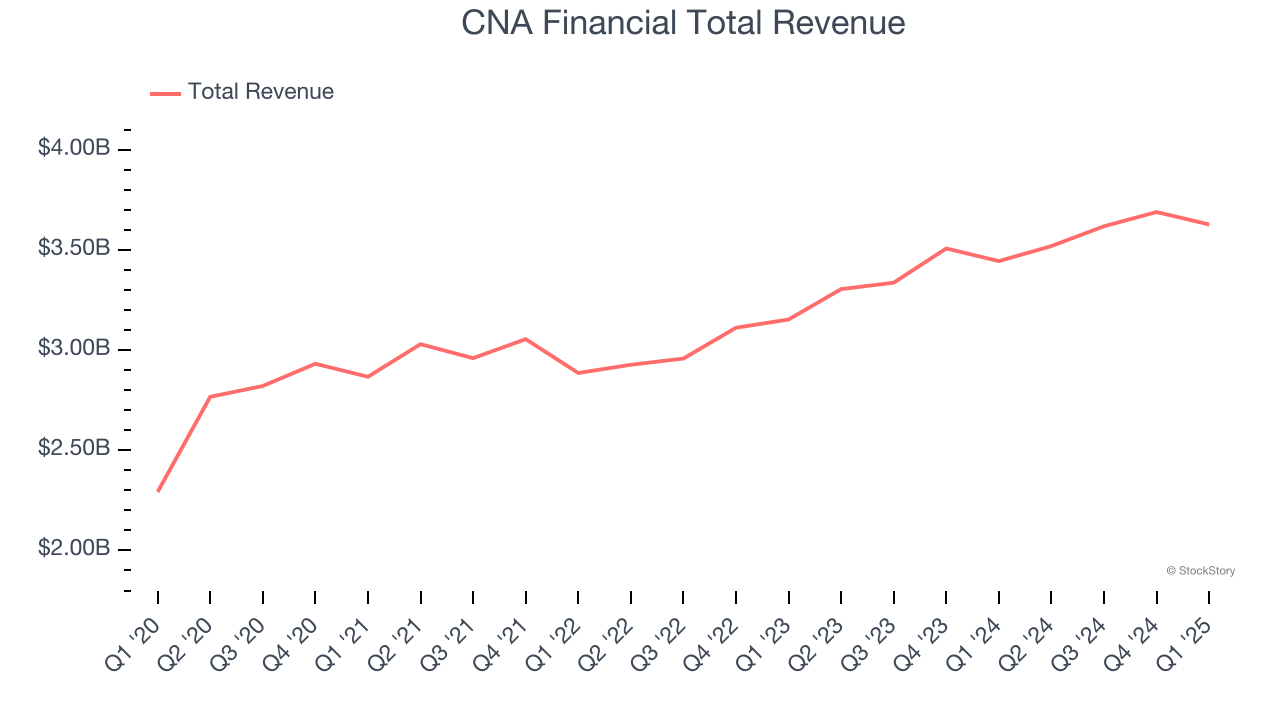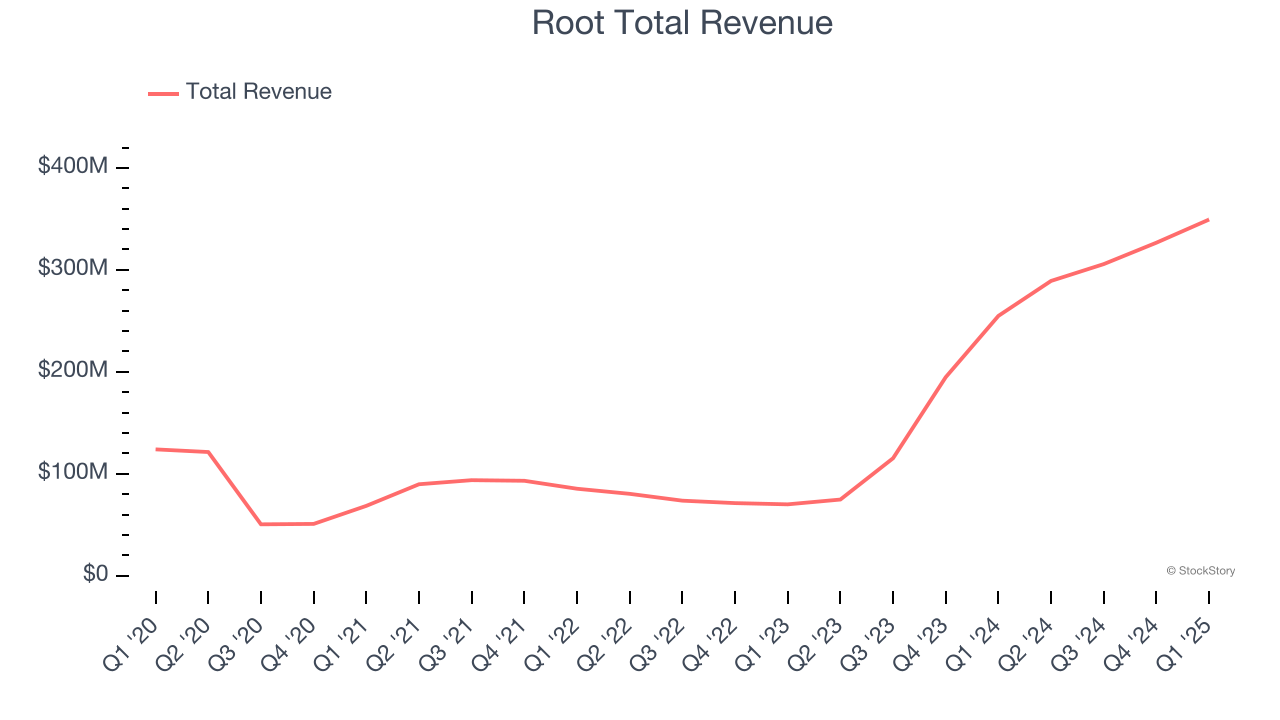
As the craze of earnings season draws to a close, here’s a look back at some of the most exciting (and some less so) results from Q1. Today, we are looking at property & casualty insurance stocks, starting with CNA Financial (NYSE: CNA).
Property & Casualty (P&C) insurers protect individuals and businesses against financial loss from damage to property or from legal liability. This is a cyclical industry, and the sector benefits when there is 'hard market', characterized by strong premium rate increases that outpace loss and cost inflation, resulting in robust underwriting margins. The opposite is true in a 'soft market'. Interest rates also matter, as they determine the yields earned on fixed-income portfolios. On the other hand, P&C insurers face a major secular headwind from the increasing frequency and severity of catastrophe losses due to climate change. Furthermore, the liability side of the business is pressured by 'social inflation'—the trend of rising litigation costs and larger jury awards.
The 33 property & casualty insurance stocks we track reported a mixed Q1. As a group, revenues beat analysts’ consensus estimates by 2.4%.
In light of this news, share prices of the companies have held steady as they are up 1.8% on average since the latest earnings results.
CNA Financial (NYSE: CNA)
With roots dating back to 1853 and majority ownership by Loews Corporation, CNA Financial (NYSE: CNA) is a commercial property and casualty insurance provider offering coverage for businesses, including professional liability, surety bonds, and specialized risk management services.
CNA Financial reported revenues of $3.63 billion, up 5.3% year on year. This print fell short of analysts’ expectations by 1.6%. Overall, it was a slower quarter for the company with EPS in line with analysts’ estimates.

Unsurprisingly, the stock is down 5.5% since reporting and currently trades at $45.69.
Read our full report on CNA Financial here, it’s free.
Best Q1: Root (NASDAQ: ROOT)
Pioneering a data-driven approach that rewards good driving habits, Root (NASDAQ: ROOT) is a technology-driven auto insurance company that uses mobile apps to acquire customers and data science to price policies based on individual driving behavior.
Root reported revenues of $349.4 million, up 37.1% year on year, outperforming analysts’ expectations by 9.1%. The business had an incredible quarter with a solid beat of analysts’ EPS and net premiums earned estimates.

Although it had a fine quarter compared its peers, the market seems unhappy with the results as the stock is down 11.1% since reporting. It currently trades at $124.69.
Is now the time to buy Root? Access our full analysis of the earnings results here, it’s free.
Weakest Q1: Fidelity National Financial (NYSE: FNF)
Issuing more title insurance policies than any other company in the United States, Fidelity National Financial (NYSE: FNF) provides title insurance and escrow services for real estate transactions while also offering annuities and life insurance through its F&G subsidiary.
Fidelity National Financial reported revenues of $2.73 billion, down 17.3% year on year, falling short of analysts’ expectations by 17.9%. It was a disappointing quarter as it posted a significant miss of analysts’ EPS estimates.
Fidelity National Financial delivered the weakest performance against analyst estimates in the group. As expected, the stock is down 9.9% since the results and currently trades at $57.99.
Read our full analysis of Fidelity National Financial’s results here.
NMI Holdings (NASDAQ: NMIH)
Founded in the aftermath of the 2008 housing crisis to bring new capacity to the mortgage insurance market, NMI Holdings (NASDAQ: NMIH) provides mortgage insurance that protects lenders against losses when homebuyers default on their mortgage loans.
NMI Holdings reported revenues of $173.2 million, up 10.9% year on year. This print beat analysts’ expectations by 3%. It was an exceptional quarter as it also produced a solid beat of analysts’ EPS estimates.
The stock is up 10% since reporting and currently trades at $43.15.
Read our full, actionable report on NMI Holdings here, it’s free.
Progressive (NYSE: PGR)
Starting as a small auto insurance company in 1937 with a pioneering focus on high-risk drivers, Progressive (NYSE: PGR) is a major auto, property, and commercial insurance provider that offers policies through independent agents, online platforms, and over the phone.
Progressive reported revenues of $20.41 billion, up 18.4% year on year. This result lagged analysts' expectations by 1.8%. Overall, it was a slower quarter as it also logged a miss of analysts’ EPS estimates.
The stock is down 8.4% since reporting and currently trades at $261.66.
Read our full, actionable report on Progressive here, it’s free.
Market Update
Thanks to the Fed’s series of rate hikes in 2022 and 2023, inflation has cooled significantly from its post-pandemic highs, drawing closer to the 2% goal. This disinflation has occurred without severely impacting economic growth, suggesting the success of a soft landing. The stock market thrived in 2024, spurred by recent rate cuts (0.5% in September and 0.25% in November), and a notable surge followed Donald Trump’s presidential election win in November, propelling indices to historic highs. Nonetheless, the outlook for 2025 remains clouded by potential trade policy changes and corporate tax discussions, which could impact business confidence and growth. The path forward holds both optimism and caution as new policies take shape.
Want to invest in winners with rock-solid fundamentals? Check out our Top 5 Growth Stocks and add them to your watchlist. These companies are poised for growth regardless of the political or macroeconomic climate.





